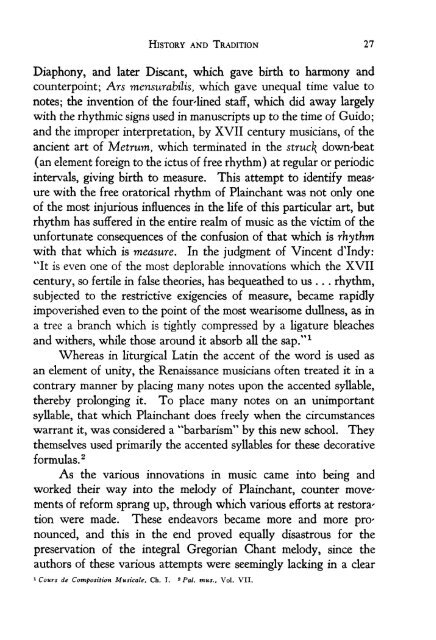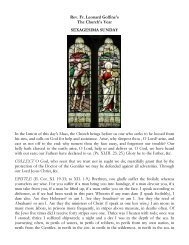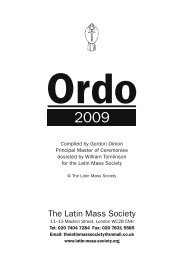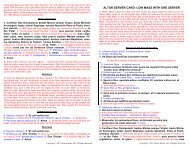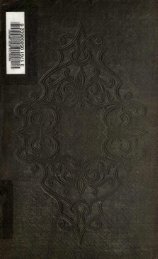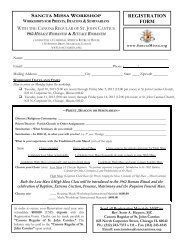The Spirit of Gregorian Chant - Church Music Association of America
The Spirit of Gregorian Chant - Church Music Association of America
The Spirit of Gregorian Chant - Church Music Association of America
You also want an ePaper? Increase the reach of your titles
YUMPU automatically turns print PDFs into web optimized ePapers that Google loves.
HISTORY AND TRADITION 27<br />
Diaphony, and later Discant, which gave birth to harmony and<br />
counterpoint; Ars mensurabilis, which gave unequal time value to<br />
notes; the invention <strong>of</strong> the four4ined staff, which did away largely<br />
with the rhythmic signs used in manuscripts up to the time <strong>of</strong> Guido;<br />
and the improper interpretation, by XVII century musicians, <strong>of</strong> the<br />
ancient art <strong>of</strong> Metrum, which terminated in the struc\ down'beat<br />
(an element foreign to the ictus <strong>of</strong> free rhythm) at regular or periodic<br />
intervals, giving birth to measure. This attempt to identify meas'<br />
ure with the free oratorical rhythm <strong>of</strong> Plainchant was not only one<br />
<strong>of</strong> the most injurious influences in the life <strong>of</strong> this particular art, but<br />
rhythm has suffered in the entire realm <strong>of</strong> music as the victim <strong>of</strong> the<br />
unfortunate consequences <strong>of</strong> the confusion <strong>of</strong> that which is rhythm<br />
with that which is measure. In the judgment <strong>of</strong> Vincent dlndy:<br />
"It is even one <strong>of</strong> the most deplorable innovations which the XVII<br />
century, so fertile in false theories, has bequeathed to us ... rhythm,<br />
subjected to the restrictive exigencies <strong>of</strong> measure, became rapidly<br />
impoverished even to the point <strong>of</strong> the most wearisome dullness, as in<br />
a tree a branch which is tightly compressed by a ligature bleaches<br />
and withers, while those around it absorb all the sap." 1<br />
Whereas in liturgical Latin the accent <strong>of</strong> the word is used as<br />
an element <strong>of</strong> unity, the Renaissance musicians <strong>of</strong>ten treated it in a<br />
contrary manner by placing many notes upon the accented syllable,<br />
thereby prolonging it. To place many notes on an unimportant<br />
syllable, that which Plainchant does freely when the circumstances<br />
warrant it, was considered a "barbarism" by this new school. <strong>The</strong>y<br />
themselves used primarily the accented syllables for these decorative<br />
formulas. 2<br />
As the various innovations in music came into being and<br />
worked their way into the melody <strong>of</strong> Plainchant, counter move'<br />
ments <strong>of</strong> reform sprang up, through which various efforts at restoration<br />
were made. <strong>The</strong>se endeavors became more and more pro'<br />
nounced, and this in the end proved equally disastrous for the<br />
preservation <strong>of</strong> the integral <strong>Gregorian</strong> <strong>Chant</strong> melody, since the<br />
authors <strong>of</strong> these various attempts were seemingly lacking in a clear<br />
1 Cows de Composition <strong>Music</strong>ale, Ch. I.<br />
2 Pal. mus., Vol. VII.


